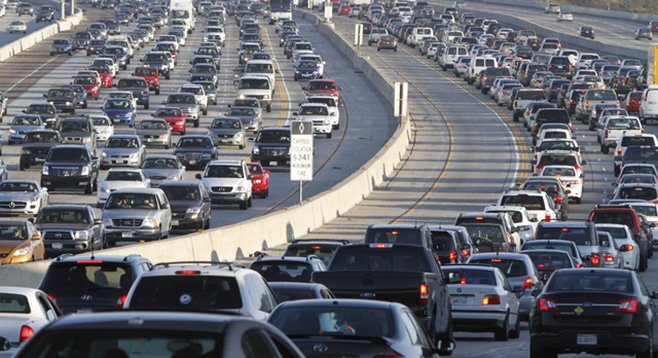 Facebook
Facebook
 X
X
 Instagram
Instagram
 TikTok
TikTok
 Youtube
Youtube

After hearing hours of commentary both in favor of and against a proposed multibillion-dollar expansion of Interstate 5 in North County, members of the California Coastal Commission gave their blessing to the plan.
The plan was supported by commission staffers and a host of local politicians. State senators Joel Anderson and Ben Hueso, state assembly member Rocky Chavez, and mayors representing all 18 of the county's cities voiced their support, as did the San Diego Regional Chamber of Commerce, Legoland California, UC San Diego, and CSU San Marcos. Dozens of orange-shirted construction union members attended, in support of the extra work the expansion would provide.
A CalTrans presentation highlighted the need for expansion, noting that 22% of the region's jobs, a share that exceeds that of the Downtown area, were based along the corridor. It was also noted that the route was the major thoroughfare shuttling tourists into the region from the Los Angeles area, and that existing suburban sprawl means that the attraction of single-occupant vehicle travel is unlikely to dissipate any time soon.
San Diego Mayor Kevin Faulconer, describing himself as an "avid cyclist," said the planned expansion, which includes miles of cycling and walking paths in addition to the addition of freeway lanes over a 27-mile stretch, would "drastically improve the quality of life for hundreds of thousands of San Diego area residents."
Individual residents and representatives of environmental groups, however, voiced strong opposition when given their turn at the podium.
Several Encinitas residents lamented the potential destruction of strawberry fields to make way for a Park and Ride lot. Dr. Mary Young, a Solana Beach resident, said the project was "fraught with problems" related to state-mandated goals to reduce climate change. Another resident suggested money for the project could be better used on converting the Coaster train service to electric power.
A host of speakers, including BikeSD executive director Samantha Ollinger, urged the Commission to hold off on approval and instead explore more transit-oriented options, something CalTrans and SANDAG was widely accused of failing to do.
The Cleveland National Forest Foundation, who earlier sued the San Diego Association of Governments over the proposal (story linked above), noted that the projections for a 30-percent increase in traffic over the next 30 years were based on outdated information. The group claims the updated projection is for a 17-percent increase, nearly all of which could be covered by a push to increase peak-period transit use by 15 percent during that time (a goal proposed by the project documents themselves), rendering the proposed expansion unnecessary.
"Sometimes, we feel like the little boy shouting 'The emperor has no clothes!'" said Foundation president Jack Shu. "I certainly feel like that today.


After hearing hours of commentary both in favor of and against a proposed multibillion-dollar expansion of Interstate 5 in North County, members of the California Coastal Commission gave their blessing to the plan.
The plan was supported by commission staffers and a host of local politicians. State senators Joel Anderson and Ben Hueso, state assembly member Rocky Chavez, and mayors representing all 18 of the county's cities voiced their support, as did the San Diego Regional Chamber of Commerce, Legoland California, UC San Diego, and CSU San Marcos. Dozens of orange-shirted construction union members attended, in support of the extra work the expansion would provide.
A CalTrans presentation highlighted the need for expansion, noting that 22% of the region's jobs, a share that exceeds that of the Downtown area, were based along the corridor. It was also noted that the route was the major thoroughfare shuttling tourists into the region from the Los Angeles area, and that existing suburban sprawl means that the attraction of single-occupant vehicle travel is unlikely to dissipate any time soon.
San Diego Mayor Kevin Faulconer, describing himself as an "avid cyclist," said the planned expansion, which includes miles of cycling and walking paths in addition to the addition of freeway lanes over a 27-mile stretch, would "drastically improve the quality of life for hundreds of thousands of San Diego area residents."
Individual residents and representatives of environmental groups, however, voiced strong opposition when given their turn at the podium.
Several Encinitas residents lamented the potential destruction of strawberry fields to make way for a Park and Ride lot. Dr. Mary Young, a Solana Beach resident, said the project was "fraught with problems" related to state-mandated goals to reduce climate change. Another resident suggested money for the project could be better used on converting the Coaster train service to electric power.
A host of speakers, including BikeSD executive director Samantha Ollinger, urged the Commission to hold off on approval and instead explore more transit-oriented options, something CalTrans and SANDAG was widely accused of failing to do.
The Cleveland National Forest Foundation, who earlier sued the San Diego Association of Governments over the proposal (story linked above), noted that the projections for a 30-percent increase in traffic over the next 30 years were based on outdated information. The group claims the updated projection is for a 17-percent increase, nearly all of which could be covered by a push to increase peak-period transit use by 15 percent during that time (a goal proposed by the project documents themselves), rendering the proposed expansion unnecessary.
"Sometimes, we feel like the little boy shouting 'The emperor has no clothes!'" said Foundation president Jack Shu. "I certainly feel like that today.
Comments